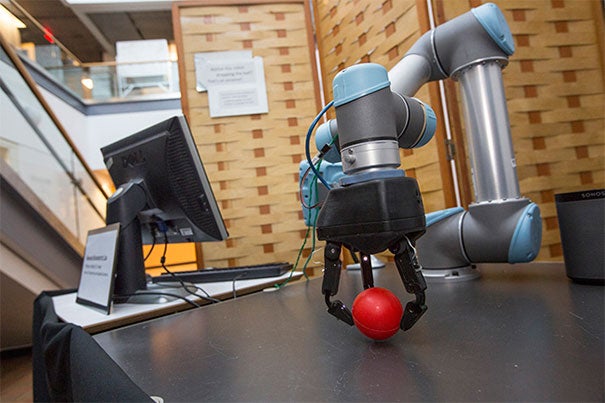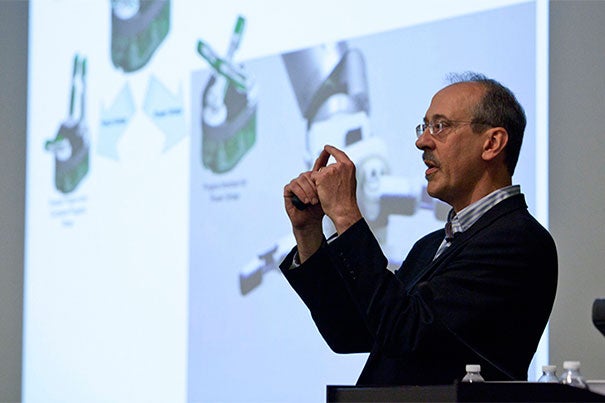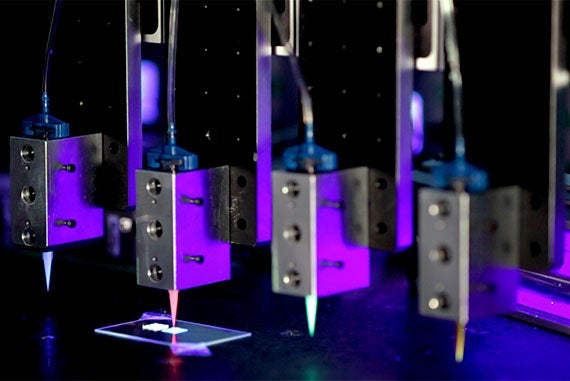
Professor Robert Howe’s research team realized their robotic grasper could have an even wider reach beyond the lab, streamlining tasks in logistics, distribution, or manufacturing.
File photos by Eliza Grinnell/Harvard SEAS
Accelerator Fund boosts Harvard tech startups
It helps launch technologies in engineering and physical sciences, and companies in robotics, 3-D printing, and materials discovery
Some ideas hatched in university research labs need a little nudge to take off into the real world.
Take the robotic hand designed by Professor Robert Howe and his research team. Grasping and manipulating irregular objects is an incredibly challenging task for robots. But in 2012, Howe’s robotic hand managed to outperform its rivals in a competition sponsored by the Defense Advanced Research Projects Agency. Autonomously picking up a basketball, swinging a hammer, and lifting a door key off a table, the hand proved adaptable and robust. The research team began to see that this gentle grasper could have a wider reach beyond the lab, streamlining tasks in logistics, distribution, or manufacturing.
“Our robot-hand technology had reached the point where there were some real-world applications,” said Howe, the Abbott and James Lawrence Professor of Engineering at Harvard School of Engineering and Applied Sciences (SEAS). “It was time to kick it out of the nest.”
Enter the Physical Sciences and Engineering (PSE) Accelerator, a fund to help technology projects clear the last few steps to market. Harvard’s Office of Technology Development (OTD) launched the PSE Accelerator in 2013, having successfully run a similar fund for biomedical projects since 2007.
“Our goal is simple: to identify technologies with strong commercial potential that require some additional translational development to be commercialized,” said Sam Liss, a director of business development at OTD. “The accelerator provides our faculty with the critical funding necessary to position these technologies as the platform for a startup, as a license to an existing company, or to attract additional research funding from a commercial partner.”

It doesn’t always take much to advance the projects to that stage. The PSE Accelerator offers funding of $50,000 to $100,000 to each selected project, for research to be performed over a period up to a year. A committee of technology experts, venture capitalists (VCs), and entrepreneurs evaluates dozens of proposals, and chooses four projects to fund in the first year and six more in the next.
Stan Reiss, M.B.A. ’00, a general partner at the venture capital firm Matrix Partners and a judge on the committee, said the grant-winning projects already have demonstrated how accelerator funding can help expand a project’s reach from research lab to commercial impact.
“The key benefit of the accelerator is that it bridges the gap between an academic research project and what’s required for a startup to successfully raise capital,” he said. “VCs want to fund something that looks and smells like a business.”
Indeed, three of the four projects supported in the first year are already in the process of forming startups. With a $100,000 grant, Howe’s team set up RightHand Robotics to develop the robotic hand for use in industry.
“In order to evolve it for the commercial market, we’ve had to cut the cost of the components, simplify the sensing and electronics, put it on a weight-loss diet, and make it much more reliable,” Howe said. Just testing its reliability has been a painstaking process, he said. “If you want a failure rate of one in 10,000, you better do 100,000 trials.”
RightHand Robotics is now in residence at the Harvard Innovation Lab (i-lab), where the Venture Incubation Program provides space, mentoring, and additional support while the four co-founders reach out to possible customers and refine their business plan. The hand, for instance, could be used to pack products in e-commerce warehouses.
“Right now people go in, and as the material goes by on a conveyor belt, they have to pick it out and set it in the appropriate direction. It’s dangerous,” said Howe. “If you have a robot that can work quickly, cheaply, and accurately, that can be quite a big win.”

Jennifer A. Lewis, Hansjörg Wyss Professor of Biologically Inspired Engineering, has used her award to help launch a startup called Voxel8 that creates electronic devices using 3-D printing.
Alán Aspuru-Guzik, professor of chemistry and chemical biology, has used his $100,000 grant to advance his chemistry technology to the point where it can launch a startup. Calculario, a materials-discovery company, leverages advances in quantum chemistry and machine learning to target advanced materials in a range of high-value markets. Aspuru-Guzik said the accelerator funding was crucial in covering “the missing mile between where we [were] in the research and a place where this can be commercialized.”
But he and Howe say the accelerator has done more than simply provide funding. “The Office of Technology Development has been incredibly helpful, making connections with a huge network of venture capitalists, angel investors, entrepreneurs, and other resources,” Howe said.
That mentorship is key, said Reiss, because potential entrepreneurs must answer a new set of questions. “What’s the market? What are the competitors? What would we sell it for? What’s necessary to have a whole product that someone could buy?” he said. “They need guidance to be able to answer these questions.”
To that end, OTD staff and Reiss found an experienced entrepreneur and Harvard Business School alumnus who was willing to help Aspuru-Guzik’s young company develop its business plan.
Reiss believes that Cambridge is an ideal place to foster startups in the physical sciences. “We are world-class in materials,” he said. And because physical processes can be modeled in ever more detail by computers, “the speed of breakthroughs is accelerating and is going to continue to accelerate.”
Researchers interested in applying for PSE Accelerator funding may contact Mick Sawka in OTD for details on the application process, which starts in summer and fall with the submission of a simple, summary proposal.




